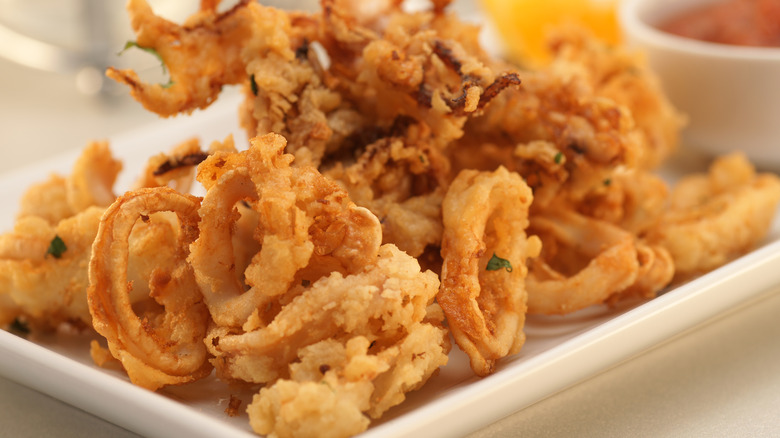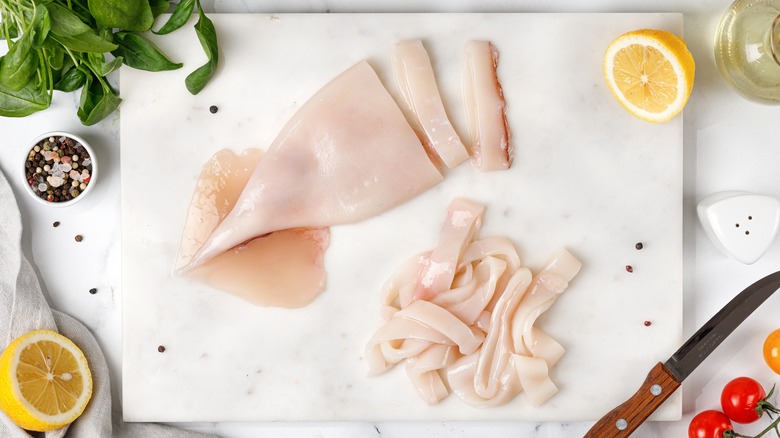Fry Your Next Batch Of Calamari In Cornmeal For Extra Crunch
Crisp up your next batch of homemade calamari with cornmeal for a light and crunchy coating.Traditionally made with flour or a mixture of flour and cornmeal, "calamari fritti," as it's known in Italian, takes on a newfound crispness by way of cornmeal. Frying foods coated in cornmeal has been practiced for quite a while — think of Southern classics like fried green tomatoes, fried catfish, fried shrimp ... you get the idea.
Calamari, as defined by Merriam-Webster, is "squid used as food." Calamari Fritti, then, translates to fried squid, as "fritti" is the masculine plural of the adjective "fritto," which is derived from the verb "friggere," meaning "to fry." The practice of eating calamari has ancient roots stemming back to the Greeks and Romans, but it wan't until the '80s that eating squid became popularized in the U.S., thanks to a genius marketing ploy by the Cornell Cooperative Extension and government agencies to market it as "calamari" to entice U.S. consumers to try it.
The New York Times notes that the term "calamari" appeared only a few times its news coverage starting as early as 1975. But it wasn't until 1980 that "fried calamari" became part of the collective lexicon, with the term peaking in the paper's coverage in 1996. Now, fried calamari appears on menus across the country, and not just at Italian eateries.
How to prepare the crispiest calamari
For the crispiest calamari, the first step is to assemble your ingredients. Classic fried calamari recipes will call for squid (whole, tubes and tentacles, or pre-cut), flour, corn flour or cornmeal (or a combination), milk or buttermilk (you can make homemade buttermilk if you don't have it on hand), oil for frying, and seasonings. For extra crunch, choose a cornmeal mixture as the coating. Multi-purposed cornmeal has a coarser texture to that of flour yet is not as heavy as other breading, like breadcrumbs. Use on its own, mix with flour, or, for a naturally gluten-free alternative, combined with corn flour.
Next, you'll need to prepare the squid. If you're working with whole squid, you'll need to remove the head, guts, ink sack, and beak, then slice off the tentacles and remove the cartilage from the tail before slicing rings. Or, buy fresh or frozen cleaned squid whole or pre-cut directly from the supermarket fish department. Whichever method you choose, keep the calamari rings no smaller than 1/2" in thickness.
Now it's time to get your hands dirty. First, pre-soak the calamari in buttermilk up to 24 hours. This will tenderize the meat and allow the breading to stick better. After soaking, remove the calamari from its buttermilk bath and dredge it in the seasoned flour and cornmeal mixture, shaking each piece to remove any excess. Fry the calamari in batches using a hot, neutral oil, and allow them to drain before plating.
What's the deal with cornmeal?
Cornmeal is made from dried dent corn that's been ground into a flour, or "meal." Sometimes called "field corn," dent corn gets its name from the small dents on its kernels. This type of yellow corn is the most widely grown in the U.S. With a higher starch content than sweet corn and a pronounced corn "flavor," dent corn is preferred for making byproducts.
Cornmeal ranges in textures, from fine to coarse. It can be stone-ground (which preserves the whole grain), or, for the more conventional item lining store shelves, can be processed through steel rollers with the bran and germ removed (known as "degermination"). Fine and medium ground cornmeal is typically used for baking and dredging. Save the coarser ground meals for more porridge-y style dishes resembling the similar, yet different, corn byproducts of polenta and grits.
Cornmeal comes in various colors, including yellow, white, blue, and red, dependent on the color of the corn kernels used. Yellow cornmeal is said to have a sweet flavor, whereas white has a more delicate flavor. The rarer blue cornmeal has a gray appearance and a sweet, slightly nutty flavor. Red cornmeal, a substitute for fine yellow cornmeal, adds a light red color to dishes. For calamari, however, stick to the yellow or white versions.


